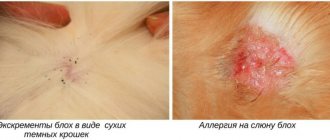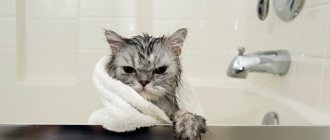Fleas are a problem familiar to most cat owners. Small blood-sucking insects can even settle on a domestic cat that has never left the apartment. Pets walking outside are exposed to not only fleas, but also ticks.
One of the effective means for getting rid of parasites and protecting against them is shampoo.
Types of shampoos
Flea shampoos for cats according to the principle of action are divided into two main groups:
- medicinal – rather aggressive agents, the active preparations of which are insecticides that destroy parasites;
- preventive – do not contain toxic components and are used to protect animals from fleas and ticks.
Flea shampoo is available in two forms:
- liquid – used as a regular detergent;
- dry – in the form of powder, which is applied to the animal’s fur and skin, and then thoroughly combed out.
Professional
Which variety to choose is up to each cat owner to decide for himself, based on his preferences and experience.
How to avoid re-infection
If you simply treat your cat with anti-parasitic detergent, fleas may soon reappear on the skin. Often insect larvae and eggs develop in the rug on which the animal sleeps, and after a few days the parasites will move to its fur. To completely get rid of insects, thoroughly wash all areas where your pet likes to lie. A solution of Bars shampoo is suitable for this purpose. After treatment, place insect repellent herbs under the cat mattress.
It is possible to see fleas on an animal’s body only when they have bred in large numbers. Single individuals are very difficult to notice. When several animals live in an apartment, but fleas have settled in the fur of only one cat, they will definitely spread to other furry pets. Carry out simultaneous treatment of all cats and dogs, as well as their sleeping places.
It is not recommended to allow animals on beds, chairs and sofas, but in most families this rule is not observed. If your cat likes to sleep on upholstered furniture, you need to thoroughly clean the room and treat all surfaces covered with fabric with flea repellent.
Composition and purpose
Flea and tick shampoo for cats is designed primarily to kill parasites and prevent re-infestation. But in addition to the main task, shampoos perform several more functions:
- cleanse skin and coat;
- help maintain freshness;
- strengthen the coat and make it softer;
- treat some skin diseases.
The most common active ingredients in medicinal shampoos are:
- pyrethrin is a natural insecticide;
- pyrethroids – synthetic analogues of pyrethrin;
- phenothrin;
- etofenprox.
These substances act not only against fleas. They cope with lice, lice and other parasites.
The preventative flea shampoo contains essential oils (wormwood, lavender, tea tree, eucalyptus, thyme, etc.) as active ingredients.
Detergent "Clandestine"
If you have never used anti-flea shampoos for cats, it is advisable to consult a veterinarian before using it for the first time. Taking into account the age, state of health and the number of parasites that have settled in the cat’s fur, he will tell you what is the best way to wash the animal. If it is not possible to consult a specialist, the instructions for the drug will come to the rescue. You need to be especially careful when treating kittens, pregnant, old and weakened cats.
Regular hygienic shampoo will help wash away some of the parasites, but it will not cause them to go away. After washing, surviving fleas can crawl throughout the apartment, and soon they will again settle in the warm and nourishing hair of the animal. In addition, conventional products do not affect insect larvae and eggs.
To prevent medicated shampoo from harming your pet, wash the animal in a certain sequence. First, calm the cat, caress it, and then do the following.
- Take the animal under the belly and hold it tightly.
- Apply shampoo to the body, avoiding the ears and muzzle.
- Keep the cat in the basin for the time indicated in the instructions.
- Wash off the product with warm water.
- Examine the animal's face. If fleas have moved in, comb them out and destroy them.
- Comb the fur.
- Dry the animal with a towel or hairdryer.
“Clandestine” shampoo against fleas also protects animals from ticks. Extracts of medicinal plants promote the healing of wounds on the skin. Under their influence, the fur becomes soft and the pet takes on a well-groomed appearance. If there is a large infestation of parasites, the effectiveness of the procedures is low; this drug is more suitable for preventing and repelling insects.
We invite you to familiarize yourself with: Kakadu pepper, a highly productive sweet variety
“Clandestine” shampoo has a gentle effect on the skin and mucous membranes. In case of accidental contact with eyes, it does not cause irritation. Suitable for bathing kittens. The composition includes vitamin B5, under its influence the hair follicles become stronger.
You need to know how to properly bathe a kitten with flea shampoo so as not to harm its body. Instructions for use:
- If the animal is being washed for the first time, it should be prepared in advance. To do this, you need to calm the animal and let it touch the water with its paws.
- Next, prepare a bowl of warm water.
- Plug the animal's ears with cotton wool soaked in vegetable oil.
- The cat is washed most often using a shower.
- Next you need to use shampoo. You need to squeeze the amount onto your hand and cover your pet’s fur from top to bottom using circular movements.
- The detergent composition is washed off by rain.
Knowing how to wash a cat, you can avoid harming its body.
Before washing your kitten, you need to heat the water to a temperature so as not to burn your pet. Next, you need to hold the pet with one hand and perform the procedure with the other.
After applying the detergent, you need to leave it on the wool for 5 minutes. If you do not wash it off for longer, your pet may become poisoned. Many owners ask whether it is possible to bathe a pregnant cat. Please consult your veterinarian before using the cleanser. The same applies to the condition of the pet after sterilization.
A common question is whether it is possible to wash a one-month-old kitten with flea shampoo. At an early age, blood-sucking parasites can cause irreparable harm to the animal's body. Pet stores have special flea shampoos for kittens that can be used at 1 month. Veterinarians advise starting to use them at 2 months.
Knowing how often you can bathe kittens and adult cats, you don’t have to worry about their health. At an early age, it is necessary to use a detergent only after consulting a veterinarian.
How many times to wash your pet is influenced by the frequency of parasite damage and the body’s reaction to chemical components.
Flea shampoos for cats can be purchased at any pet store. They effectively help against blood-sucking insects and can be used for prevention.
Additional components in the composition of medicinal shampoo
In addition to active ingredients that destroy or repel parasites, the shampoo contains auxiliary substances that enhance its effectiveness. Among them:
- Surfactants (sodium lauryl sulfate, glycerin laurate) substances responsible for foaming and cleansing;
- extracts of medicinal plants (chamomile, celandine, coltsfoot, calendula) soothe the skin, reduce irritation and itching;
- flavorings;
- salicylic acid (has an anti-inflammatory effect);
- caring and nourishing ingredients;
- water.
Before using flea shampoo, you need to carefully read the composition.
How to choose anti-flea shampoo for cats
Before choosing an anti-flea shampoo for cats, you should carefully read the instructions, which provide information about the possibility of its use during pregnancy and lactation. The age of the animal, the holding time of the drug, precautions, contraindications and shelf life must also be indicated.
Important! The absence of such information indicates the dubious quality of the product or indicates its counterfeit.
The following is an overview of the most popular detergents, according to reviews from owners and veterinary specialists.
Mechanism of action
How exactly certain flea shampoos work depends on what active ingredients are included in their composition. If the product contains insecticides, they act on parasites upon contact directly during washing. The substance disrupts the transmission of nerve impulses in insects, causing paralysis and death. In addition, the poison destroys the shell of the eggs and kills the larvae.
Application
Preventative shampoos work differently. They contain essential oils, the smell of which insects cannot stand. After the cat is washed, the smell remains on the fur and repels insects, protecting the animal from their attack. Before bathing your cat, it is advisable to check how she reacts to the smell that she will have to wear for more than one day.
How to properly wash a cat
If you choose an antiparasitic shampoo to fight fleas, you need to act strictly according to the instructions and quite promptly. You should ensure that your pet cannot swallow the components of insecticidal agents and that they do not get on the mucous membrane of the eyes, nasal passages and mouth.
To prevent intoxication, the animal should be bathed according to a certain pattern. Movements should not be sudden so as not to scare the pet. The cat should be held under its belly to prevent escape. The shampoo is applied to the coat, excluding the head. The exposure is maintained according to the instructions. After this, the antiparasitic agent should be washed off with plenty of water. Then we carry out the procedure of combing and drying the wool. Actions should be clear and quick, this will reduce stress from water procedures.
If your furry pet is panicking, it is better to use dry shampoos or other methods of combating ectoparasites.
Do cats need to be washed frequently? Flea remedies are used only when necessary, since the components of the shampoo wash away the lipid layer of the skin and toxic substances, if used incorrectly, can accumulate and cause symptoms of poisoning .
Instructions for use
Each anti-flea shampoo has its own characteristics, including the rules of use. Before using the product, be sure to study the instructions, decide on the dosage and procedure.
How to treat an animal with soap?
How to wash a cat is decided by the owner, focusing on the pet’s character, his attitude to the washing process, and aggressiveness. Several recommendations will help make the process more comfortable for both parties and more effective:
- the water should be slightly warmer than room temperature;
- the water level in the bath or basin should reach the animal approximately to the stomach;
- the wool should be moistened generously with water, without touching the head;
- the shampoo is applied to the back and foamed properly, distributing it throughout the body, then you need to wait the time specified in the instructions;
- The product must be thoroughly rinsed with plenty of water (it is most convenient to use a shower).
After washing your pet, you need to comb it to remove dead insects, eggs and larvae.
Frequency of the procedure
You should not wash your cat too often with medicated flea shampoos, since the chemical insecticidal substances included in their composition can gradually accumulate in the body, causing intoxication, and in addition negatively affect the condition of the coat.
It is enough to wash your cat once to rid him of fleas. In a neglected state, it is allowed to reuse the shampoo 5 - 7 days after the first wash. But after this you need to take a break for 2 months.
Herbal shampoos contain natural ingredients, so they can be used without fear for the cat’s health. Preventive shampoo can be used every 10 to 15 days, but in general the frequency depends on how long the product lasts.
How long does the effect last after using the drug?
Medicinal shampoos act immediately, fleas die during the washing process. The effect of phytoshampoo can last from 8 – 10 hours to 2-3 weeks after bathing. It all depends on what ingredients are included in the product and in what concentration.
What is recommended to combine anti-flea shampoo treatment with?
To enhance the effect, the use of shampoo is often combined with the use of other antiparasitic agents.
Collar
It can be:
- flea drops;
- sprays;
- anti-flea collar.
Usually the scheme is as follows: the cat is first washed, and then flea drops or spray are applied or a collar is put on. Before combining products, it is advisable to consult a veterinarian. Some drugs can mutually enhance the toxic effects of each other, which will lead to intoxication of the animal.
Rules of application
If the animal is accustomed to contact with water, then the procedure is not particularly difficult.
Anti-flea shampoo must be used in accordance with the recommendations so as not to harm the animal:
- rinse the cat with warm water so that the fur becomes damp;
- dose the drug according to the manufacturer's recommendations;
- Apply to fur, massage until thick foam forms;
- You need to wash your cat with shampoo very carefully: make sure that the product does not get into the eyes or ears;
- wait 3-6 minutes, rinse the wool thoroughly with running water;
- blot the fur with a dry, clean towel, dry it, and comb it with a special comb.
If some of the insecticidal shampoo gets into your pet's ears or eyes, they should be immediately rinsed with plenty of water. After using the shampoo, the fleas die immediately.
If the animal is afraid of water, then using shampoo is more difficult. You need to fill a small basin with water and pour in the required amount of flea shampoo.
Foam the preparation, apply the resulting foam to damp wool, leave to act. Carefully rinse off the shampoo and dry the coat. If an animal is afraid of water, then such treatment is a stressful situation for it.
It is recommended to carry out the procedure together, with an assistant, in order to hold the cat and not accidentally harm him.
How to wash a kitten
Kittens have a more pronounced and painful reaction to bites: there is an increase in body temperature, a decrease in appetite, and the development of anemia. Therefore, it is recommended to select the drug as soon as possible after the first manifestations of infection.
How to wash a kitten with anti-flea shampoo: the principle is the same as for adults.
- It is necessary to choose a drug designed specifically for small kittens.
- You should not use several products with insecticidal properties at once. Additionally, the use of drops, sprays, and powders is possible no earlier than 2 weeks after shampoo.
- You should not bathe your kitten more than once every 30 days. If there is an excessive accumulation of active components on the animal’s skin and fur, intoxication may occur. With frequent exposure to water, the protective lipid layer is damaged, causing itching and dryness of the skin.
- When using shampoo, you must strictly follow the manufacturer's instructions regarding the dosage regimen.
- It is necessary to ensure that the kitten's fur is thoroughly dried. In the first case, a cold is possible with an increase in body temperature and a general deterioration in well-being. In the second, the animal begins to lick itself independently and can become poisoned by the active insecticidal substance. For the same reason, it is recommended to select products with high-quality, hypoallergenic, non-toxic composition.
- If the kitten is under 14 days old, then the use of flea shampoos is contraindicated.
Most flea shampoos for kittens can be used from 1 month.
You must first carefully study the instructions for use and possible restrictions on use.
Video
Dry shampoo for cats in the form of a spray 8in1 / 8in1 Perfect Coat Waterless Shampoo
Flea shampoos for kittens and pregnant animals
Many flea shampoos are approved for use on kittens starting at two months of age. These are, for example, Gamma and Celandine. Only a few manufacturers make products that can be used to get rid of fleas in kittens starting at 4 weeks of age. These include Fitoelita, 4 with a tail.
When washing pregnant cats, it is also safer to use gentle products, after consulting with your veterinarian. Suitable shampoos include: Doctor Zoo, Four with a Ponytail.
Where can I buy
| Pharmacy name | Address | Drug name | How much does it cost, rub |
| Pet store on Olimpiyskiy | Moscow, st. Olympic Avenue, 16, building 5 | Dana Api-San | 111 RUR |
| Zooexpress | St. Petersburg, Irinovsky pr., 1 | Dana Api-San | 124 RUR |
| Online store Deal.by | Shampoo "Talc" | 71 bel. R | |
| Online store "Petplanet" | FRANCODEX | 179 UAH |
How to use the product correctly
As a rule, flea shampoos for cats are used for hygiene procedures, and also allow you to combine bathing and insect treatment. How to wash a cat with flea shampoo?
- Before bathing, you should study the instructions, then prepare a bath or container with warm water, as well as all the necessary equipment.
- The animal should be picked up, then placed in a bath of warm water and the fur slightly wetted.
- Apply anti-parasite product, thoroughly rinse all areas of the body and fur, avoiding contact with the face and ears.
- Leave the product on for a few minutes.
- After this, you should thoroughly rinse off the shampoo, wipe the cat dry, and then comb the fur and dry it.
A detailed video on use can be viewed below.
After a couple of days, carefully examine the animal's skin and fur for any allergic reactions or remaining insects. If necessary, the procedure can be repeated. It is worth knowing how often you can wash your cat with flea shampoo, because... too frequent use can lead to intoxication of the animal and loss of shine in the coat. So how often can you bathe your cat? It is best to use flea shampoo once every six months.
If you are wondering whether it is possible to wash a pregnant cat with flea shampoo, then your doubts should be dispelled: the product will not affect the course of pregnancy in any way. But whether it is possible to wash a dog with a product for cats is a controversial question. Because The calculation of the dose depends on the weight of the animal, but for small dogs this remedy can be used.
Treating kittens against parasites
Before using the product on kittens, you should be careful, use specialized shampoos for kittens against fleas, and also know at what age and how often you can bathe a kitten with flea shampoo.
Often, people wonder at what age can they bathe a kitten with flea shampoo. You can use flea shampoo even for very small kittens, 2 months old, but be sure to use a product with a lower concentration of permetinoids and make sure that it does not remain on the fur after washing.
Why go to the vet?
If your cat starts itching a lot, frantically licking itself, biting its skin and fur, then most likely it has fleas. To avoid the spread of this infection, you should begin treatment immediately. Pests multiply very quickly. If you don’t start removing them as early as possible, it will be very difficult to get rid of parasites later.
A visit to the veterinarian will be the key to effective treatment, especially if a similar situation has arisen for the first time. Only a doctor will be able to determine the degree of infection, recommend the most optimal method of treatment, and also tell you about preventive measures.
Veterinary clinics
| Clinic name | Address | Telephone | Price, rub.) |
| "GrandVet" | Moscow, st. Fedoskinskaya, 13A | (495) 488-82-11 | 500 |
| "Kitten Woof" | St. Petersburg, People's Militia Ave., 101 | (812) 425-24-61 | 500 |
| "Trilos" | Ekaterinburg, st. Strelochnikov, 5 | (343) 202-17-22 | 400 |
| "Friend" | Nizhny Novgorod, st. Konotopskaya, 4 | (831) 235-12-41 | 380 |
| "Give me your paw" | Minsk, st. Zhudro, 71A | +375 (17) 201-47-67 | 15 BYR |
| "Avet" | Kyiv, Heroev Stalingrad Ave., 8, bldg. 8 | +38 | 50 UAH |
Prevention methods
It doesn’t matter whether the cat is outside or not, the risk of becoming infected with fleas and ticks is very high. A domestic cat may well pick up parasites from other animals that live in the house, for example, from a dog, or from owners who can bring fleas on shoes and clothes from the street. To reduce the risk of infection, it is necessary to periodically carry out prophylaxis. To do this, there are various methods that effectively help avoid attacks of all kinds of blood-sucking insects.
There are many sources of information on how to treat a cat for parasites, including folk remedies. Below are the best measures to prevent your cat from getting fleas and ticks:
- using a special anti-flea collar, even if the cat walks only in the summer and only on the balcony or breathes through the window;
- treatment with drops of animal hair, feeding with anthelmintic tablets no more than once every six months;
- washing with special shampoos. How often can cats be washed with flea shampoo as a preventive measure? The answer to this question is the same as in the previous paragraph: no more than twice a year. Many people are also interested, if the cat is nursing, whether it can be washed with flea shampoo. It is possible if the drug is very gentle, since kittens will lick it off along with the milk when feeding and may become poisoned. How flea shampoo for cats works and how to use it are indicated on each package, so using this product will not be difficult;
- thoroughly combing out dead fleas, as well as their larvae, after each treatment with a fine-toothed comb;
- the use of serious drugs can lead to problems with the skin and coat. Therefore, the restoration of the animal’s health after treatment must be accompanied by the intake of vitamins.
Criteria for choosing flea shampoo for cats
Of course, when purchasing flea shampoo for cats, you should give preference to products from well-known manufacturers and buy them only in specialized stores. But when choosing a product, you need to consider a few more points:
- age of the pet (very small kittens can only be washed with special low-toxic shampoos);
- condition of the cat (illness, pregnancy, lactation);
- purpose of use (if you need to get rid of existing parasites, use medicated shampoos with insecticides; to protect cats from fleas and ticks, safer products based on natural ingredients are suitable).
In addition, you need to take into account the characteristics of your pet’s coat. There are varieties for long-haired and short-haired cats, and the product that meets this criterion will be most effective.
From what age can it be used?
As a rule, a kitten can be bathed with flea shampoo from 8 weeks. But there are drugs with a gentle composition that can be used from the 2-3rd week. They are prepared on the basis of plant extracts, therefore they are safe for animals and repel parasites quite well.
If newborn kittens are infected with fleas, the mother cat needs to be treated with an insecticidal preparation. To do this, on the recommendation of a veterinarian, they buy drops on the withers and shampoos that can be used during lactation.
It is not recommended to wash kittens immediately after birth. They are still very weak, and it will be difficult for their body to cope with such stress.
In advanced cases, it is allowed to treat the baby with a weak solution of flea shampoo or tar soap. You need to wash your pet as quickly as possible so that he does not catch a cold.
The most painless option is to comb your baby with a fine-toothed comb. During the process, the animal is held over a bowl of water so that the fleas do not run away, but fall into it.
Important. You cannot wash your pet if it is sick. They also refuse to bathe for 14 days after vaccination, since during this period the animal’s immunity weakens.
Types of flea shampoos
This is the list of the best flea shampoos for cats according to veterinarians and pet owners:
- Celandine;
- pet shampoo Bars;
- 4 with a tail;
- Lugovoi shampoo;
- BioVax;
- Gamma;
- AVZ Elite Organic;
- Rolf Club;
- Barsik.
Varieties
Why bathe a cat and what is needed for this?
Many people notice that cats spend several hours a day on their personal hygiene duties. And the point is not at all that this type of animal is especially clean given its self-sufficiency and independence, as many of us are accustomed to believe. There are quite objective physiological reasons for this:
It is best to introduce a cat to bathing when it is still quite young. Small kittens rarely react negatively to being forced into slightly warm water, especially if the owner acts with confidence, speaks gently and behaves in a calming manner. In this case, if there is an emergency need to bathe the cat, the animal will already be familiar with the procedure.
Advantages and disadvantages of application
Flea shampoos are quite popular among cat owners. This is easily explained, because the funds have many advantages:
- ease of use;
- Can be used for cats of any breed;
- low toxicity compared to other agents;
- efficiency;
- additional positive effect on the condition of the coat.
Another advantage is that shampoos have virtually no contraindications, and when used correctly they are safe for your pet.
But the funds also have disadvantages:
- short period of protection (no more than 20 days);
- risk of an allergic reaction to some ingredients;
- the categorical refusal of some pets to participate in water procedures, which is why an attempt to wash them is unsuccessful, and in the worst case it ends in deep scratches for the owner and stress for the cat.
The disadvantages include the fact that cheap products are ineffective, and high-quality shampoos that give long-term results are expensive.
Contraindications for washing
Despite the fact that it is necessary to wash cats, there are a number of contraindications when such a home procedure is either completely unacceptable or must be carried out with great caution.
First of all, you need to remember that for a cat that has not been accustomed to water since childhood, washing becomes very stressful.
. Therefore, breeders recommend accustoming a kitten to washing 3-4 weeks after it is brought to its new home. This will make caring for your pet easier in the future and will relieve him of his panicky fear of water and the noise it makes.
Due to the stress experienced during the washing period, the animal receives a huge load on the heart. Therefore, it is not recommended to carry out water procedures for cats in old age.
Additional contraindications not based on the age of the cat include:
- late pregnancy;
- during early pregnancy, the cat can be washed, but very carefully and when there is a significant need;
- kitten feeding period; You should not wash a nursing cat because it may simply lose milk;
- in the presence of serious illnesses or recent surgery.
You should also limit water treatments when the apartments become cold and there are drafts. These points can become the basis for the animal’s illness. The temperature in the room where the cat will be after washing should not fall below +22 degrees, and windows and doors should be tightly closed.
Washing a cat is a short process, but can cause a lot of problems. When deciding to give your pet water treatments, you should be patient, speaking gently and calmly to the animal during the washing process. And after the second or third time, the pet will begin to treat this procedure more calmly, without experiencing too much stress and without leaving numerous scratches on the hands of the owners.
Cat care
Cats are afraid of water, then how to wash a cat and whether the procedure is necessary. What is needed for bathing and is it possible to wash a cat with regular shampoo. When not to bathe a cat.
Many cat owners shudder when faced with the prospect of bathing their pet. Past bitter experiences or embellished stories from friends often conjure up images of a wet chaos in the apartment, a poor tortured animal climbing on the walls out of fear, or, even worse, on hands with its claws fully extended. As a result, most owners try to completely avoid bathing their beloved pet, hoping that the cat will serve itself, by licking, for example. How to wash a cat if she is afraid of water? We offer a complete guide.
In fact, cats can be easily trained to follow a regular bathing routine. Professional breeders often shower their animals as part of their care. Continuous repetition of the procedure accustoms cats to water in the same way that their larger wild cousins learn to swim in rivers, catch fish and even play in the shallow waters of lakes and streams. A cat is afraid of water - this is a myth, it is simply unpleasant for her.
Cats that are not used to bathing do often panic at first, but you need to remember that most animals will be happy to be in the “heavy rain.” The main idea throughout the bathing process is the peace of mind of the owner. If the owner behaves relaxed and does not make sudden movements, the cat will quickly appreciate all the benefits of water treatments and will soon get used to it. At least it should.
We offer some practical tips on how to properly wash a cat, as they say, with the least loss. It is worth considering that everything described below is the basis; each owner is aware of the details of the procedure himself, drawing conclusions from each subsequent bath.
Contraindications and side effects
Like all medicines, anti-flea shampoos have a number of contraindications. These include:
- individual intolerance or hypersensitivity to the components of the drug;
- absolute rejection of water procedures by the pet and his clearly expressed reluctance to bathe.
Restrictions on the use of shampoo may be illness or weakened condition, as well as age up to 1.5 - 2 months.
If you have an allergic reaction to the drug, accidental ingestion, or too frequent washing with insecticidal shampoos, side effects may occur:
- weakness;
- increased secretion of saliva;
- nausea, vomiting;
- itching;
- dry skin;
- dull fur.
Skin reactions may indicate that a particular shampoo is not suitable for your pet. If an animal shows signs of poisoning, it should be shown to a veterinarian.
TOP 12 best shampoos for cats
Among the popular shampoos there are budget ones, with an average price tag, and more expensive ones. Here are well-known brands used by cat owners.
Beaphar
Contains 15% dimpylate solution. Excellent at killing fleas and other blood-sucking parasites. It is practically odorless, the mixture is thick with a brown tint, and does not cause allergies. It only takes 1 time to get rid of fleas. Not recommended for kittens aged 0 to 5-6 months. Also, you should not wash pregnant individuals with it, as well as during lactation. Avoid contact with eyes, ears, nose. After the procedure, you should not allow your pet to play with you for 24 hours. It is imperative to follow the dosage and recommendations indicated on the packaging. The product is in the budget line. The drug can be used on small breed dogs.
BIO-GROOM
American shampoo consisting of natural and synthetic substances. The manufacturing company specializes only in products for animals. It belongs to the middle price category and copes with its tasks perfectly. Suitable for individuals from 4 months of age. Can be used several times to completely get rid of blood-sucking insects. Safe, does not cause allergic reactions.
Important! The caring complex helps maintain the health of the skin and coat (makes it silky, clean, well-groomed). Does not require additional collars, drops or flea tablets.
Ms. Kiss
An excellent remedy for various types of parasites. It exudes a pleasant smell, has a thick consistency, lathers well, and contains no contraindications. Unsurpassed Swiss quality, natural ingredients, average price tag. Suitable for all cat breeds. It is used very economically and the drug lasts for a long time. Contains a care complex, which helps to comb the coat with ease.
Rolf Club
Shampoo from the Russian manufacturer Ecoprom. Effective from just 1 application. Suitable for all breeds of cats, harmless, contains only natural, proven substances. For animals from 3-4 months.
Leopard
The composition is similar to Barsik. Has a normal, non-irritating odor.
Important! Veterinarians advise using 1-2 times in case of infection. Not recommended for newborn kittens.
Barsik
The active substance in the composition is fipronil. Absolutely harmless to pets, maintains the shine of the coat and its thickness. Inexpensive. For cats aged 1.5-2 months. It is recommended to apply 1-2 times when parasites appear.
Biovax
Contains active antiparasitic substances. It also contains natural ingredients that maintain the thickness, strength, and shine of the animal’s coat. Does not cause allergic reactions, 1-2 uses per month are enough to fight fleas. Recommended for cats aged 2-3 months and older.
Dana (Api-San)
It is a thick mixture containing diazinon and fipronil. Recommended for use on animals over 12 months of age. 1-2 applications are enough to get rid of parasites for a long time.
Lugovoy
1 time is enough to get a strong effect. Contains only natural ingredients. These are extracts of burdock roots, lanolin, chamomile, and plantain. Eliminates many types of blood-sucking parasites. A budget drug with excellent consumer reviews.
Phytoelite
Inexpensive product from the Veda company. The store sells it in bottles of different capacities.
Important! Contains active components. When using, you must wear gloves; it is not recommended to smoke or light matches (the mixture may catch fire).
Attention! Cannot be used for allergies in cats.
Celandine
A similar drug is produced by the Russian manufacturer Ecoprom. The composition includes permethrin, aloe vera extract, vitamins, and microelements. It is recommended to use it on cats older than 2.5 months. Also contains auxiliary natural additives that support the health of the coat and skin. Does not cause irritation, allergic reactions, itching or burning. It is stored for a very long time, has a budget price tag, and is enough for a specific number of uses (one time is enough to get rid of fleas).
Dry shampoo
This remedy saves when the cat does not want to take water procedures (sick, feeding kittens). Dry shampoo is a special powder that is spread on the animal's fur. Then they leave it for a while and remove it along with the parasites. Most manufacturers include similar products in their line of antiparasitic products.
Frequency of application
The time intervals at which flea shampoos are used depend on several factors. In the first two to three days after the first wash, the pet is examined for the presence of dead fleas. It is necessary to understand how the remedy worked and whether the pet needs to be treated again. If dead insects are found, they are carefully combed out. The cat is then checked for the following:
- allergy to the drug - manifests itself in the form of skin rashes;
- the presence of live fleas in the animal’s fur;
- quality of treatment against parasites.
Based on the results of examining the pet, the owners decide whether it is worth bathing the cat again using anti-flea shampoo, and whether it is worth changing its brand. The next treatment is repeated when live fleas are detected and no earlier than 10 days later - the standard interval for such products. Before carrying out the procedure, it is recommended to carefully study the packaging of the drug with the manufacturer’s recommendations.
The frequency of bathing also depends on the situation. Even pets become infected with parasites, most often this happens in the summer. Parasites enter the house from the street, through the clothes and shoes of the owners, as well as from basements. Detecting their presence is not so difficult - an infected cat regularly licks itself and bites itself. It would also be a good idea to treat your animal with preventative shampoo 2-3 times a year, especially in the case of regular walks or frequent contact with other pets.
How to wash a kitten with shampoo correctly
Cats themselves do not like water; frequent bathing is contraindicated for them. There are no problems with those pets who enjoy bathing. Pour warm water, immerse the kitten in it, apply shampoo to the fur, foam it, distribute it evenly over the entire body except the face. You need to make sure that the product does not get into your eyes, mouth, or ears. Leave for 5 minutes, rinse thoroughly. Dry the wool with a towel or napkin and carefully comb it with a comb.
The procedure is somewhat different for pets that are afraid of water and do not like to swim. Shampoo is foamed in a basin. The wool is sprayed from a spray bottle until moistened. Apply foam, distribute over the entire body, leave for 5 minutes. All that remains is to rinse the wool, which will take no more than 3 minutes. After drying, the wool must be combed with a comb. Immobilized fleas remain on the hairs, which can be easily removed with a cat comb.
The effect of shampoo for kittens lasts for 5-14 days; babies should be bathed no more than once a week. If there is no urgent need, it is better to do water procedures twice a month.











